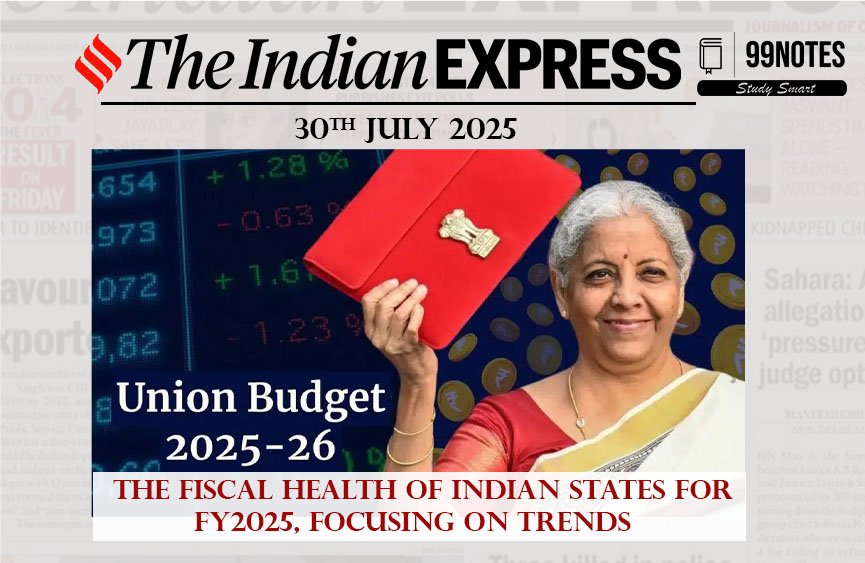30 July 2025: Indian Express Editorial Analysis
1. A Limited Borrowing Space
(Source: Editorial Page, The Indian Express)
| Topic: GS3 (Indian Economy – Fiscal Policy, State Finances, Capital Expenditure), GS2 (Governance – Federalism, Centre-State Relations, Fiscal Devolution), GS4 (Ethics – Public Resource Allocation, Transparency) |
| Context |
|
Overview
India’s 17 largest states, accounting for 90% of GDP, saw a widening fiscal deficit in FY2025, rising to ₹9.5 trillion (3.2% of GSDP), mainly due to increased revenue deficits. This limits their ability to borrow for productive investments as borrowing caps aim to maintain fiscal discipline.
Key Fiscal Dynamics
-
States are borrowing more to meet routine expenses like salaries and subsidies rather than capital projects, which affects long-term growth.
-
Capital expenditure growth slowed to about 10%, with a large portion occurring at the fiscal year-end, indicating inefficiencies.
-
The Centre’s special loan assistance for state capex has been crucial, funding around 40% of incremental capital spending, yet states remain heavily dependent on this support.
Challenges
-
Limited borrowing space constrains independent state-led infrastructure development.
-
A higher revenue deficit suggests less borrowing is used productively.
-
Rigid central schemes and untied grants limit states’ flexibility in budget priorities.
Way Forward
The editorial calls for incentivizing states to fully utilize their permissible borrowing capacity for capital spending, offering more fiscal autonomy, and instituting accountability mechanisms to reward fiscal prudence and effective investment.
UPSC Relevance
Understanding the nuances of Centre-state fiscal relations, borrowing constraints, and developmental priorities is essential for topics in Indian Economy (GS3), Governance (GS2), and Ethics in Public Resource Management (GS4). The editorial’s insights aid in analyzing real-world fiscal federalism challenges and solutions.
| Practice Question: (GS-2 | 15 Marks | 250 Words)
Examine the impact of limited borrowing space on the fiscal health and development expenditure of Indian states. How can Centre-state fiscal relations be improved to ensure sustainable and productive public investment? |
Also Read: The Hindu Editorial Analysis- 30 July 2025
2. Cracks in IT
(Source: Editorial Page, The Indian Express)
| Topic: GS3 (Science and Technology – IT sector, AI & Automation, Employment Trends) GS2 (Governance – Skilling, Economic Policy, Labour Issues, Corporate Governance) GS4 (Ethics – Workforce Management, Corporate Responsibility) |
| Context |
|
Introduction
The Indian IT services sector, once a guaranteed source of middle-class employment and global competitiveness, is witnessing a paradigm shift. Layoffs at industry giants like TCS, driven by AI and automation, have highlighted deeper cracks in the traditional business model, exposing challenges that go well beyond short-term demand dips.
The Structural Challenges
AI & Automation Disruption:
- AI is rapidly automating repetitive, entry-level jobs, making large segments of mid-level/senior employees redundant.
- Indian IT’s historic wage arbitrage model faces threat as automation undercuts the need for large teams working on basic coding, testing, or support tasks.
- Generative AI and machine learning tools can now handle routine software development and support roles, pressuring companies to restructure.
Slowdown in Hiring & Rising Layoffs:
- The sector has experienced a sharp fall in hiring—only 3,847 employees added across top six firms (April–June 2025, down 72% from the previous quarter).
- Mass layoffs, including 12,000 at TCS, and warnings of more cuts by NASSCOM signal the industry’s pivot to leaner, AI-driven workflows.
Skill Gaps and Reskilling Imperative:
- Traditional IT skills are fast losing relevance; companies now demand specialized AI, cloud, data science, cybersecurity talent.
- Mid- and senior-level employees are most at risk if they are unable to transition or upskill in emerging technologies.
- Over 1.5 million Indian IT professionals have undergone AI-related upskilling, but gaps remain.
Low R&D and Innovation Investment:
- Indian IT giants’ R&D spending remains below 1% of turnover, constraining movement up the value chain.
Broader Sectoral Implications
Impact on Labour Market:
- Job insecurity is mounting, especially among experienced and mid-career professionals.
- Entry-level hiring is stagnant; fresher opportunities have shrunk dramatically.
- The ripple effect threatens supporting sectors, including housing in tech hubs.
Challenges to the Business Model:
- The traditional model—large teams for labor-intensive outsourced projects—is under severe strain.
- Global clients now expect more innovation, agility, and AI-aligned services—to survive, Indian IT must swiftly adapt.
Competitive Advantage Under Threat:
- Wage arbitrage is no longer enough. The industry must reposition on capabilities like digital innovation, consulting, and high-end R&D.
Way Forward
-
Aggressive Reskilling and Upskilling:
Strong partnerships between companies, government, and academia to swiftly retrain professionals in AI, cybersecurity, cloud computing, and data analytics. -
Greater Investment in R&D:
Indian IT firms must boost innovation spending to transition from volume-based to value-based services. -
Focus on New Sectors:
Explore growth in 5G, blockchain, and AI-driven sectors for business resilience and employment generation. -
Reform Education & Training:
Align university curricula with industry requirements in emerging technologies. -
Social Safety Nets:
Develop robust support systems for workers transitioning out of traditional roles.
Editorial Insights for UPSC Aspirants
-
Relevance to GS3: The editorial covers tech-driven employment disruption, a recurring UPSC topic.
-
Policy & Ethics Focus: Reskilling, workforce management, corporate responsibility, and government-industry collaboration have implications for answers in ethics and governance.
-
Contemporary Significance: Understand how automation and digital transformation impact not only the economy but also the social contract in India.
|
Practice Question: (GS-2 | 10 Marks | 150 Words) |
Read more – 29 July 2025 : Indian Express Editorial Analysis



